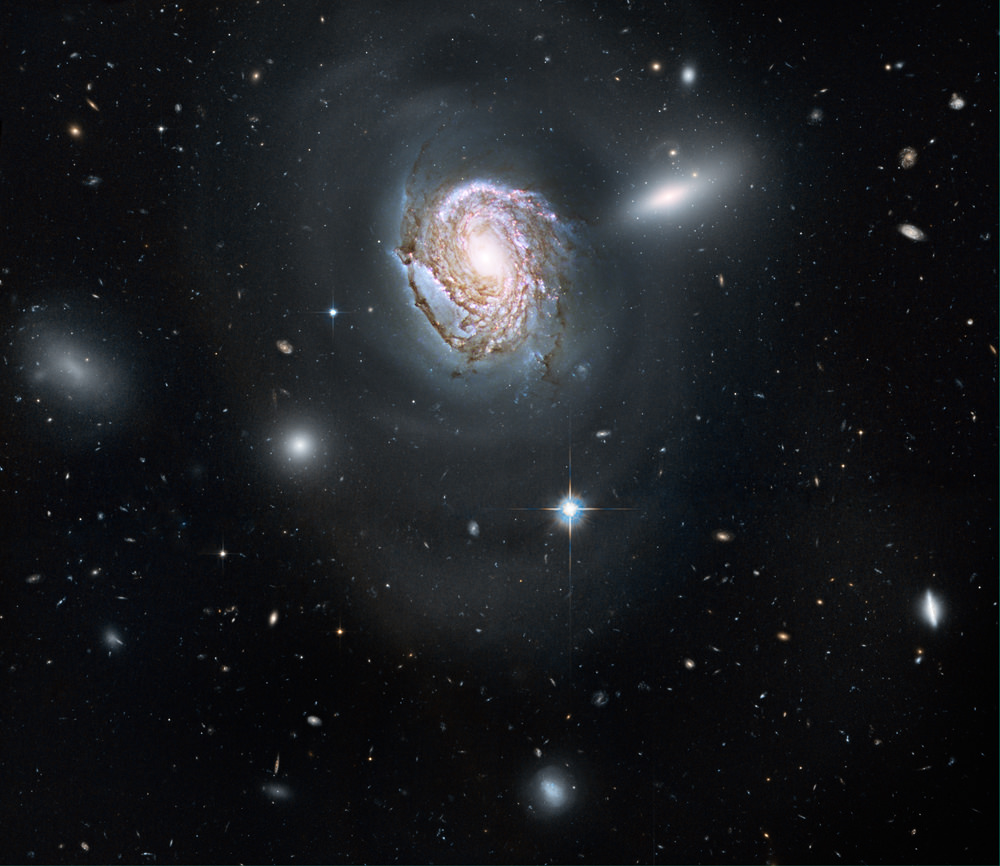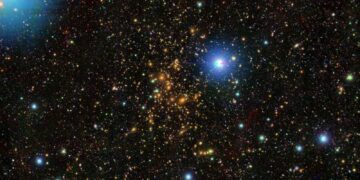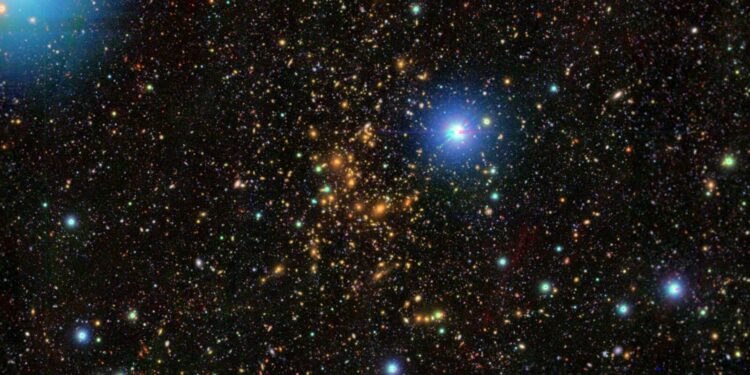Machine learning has once again transformed our understanding of the universe, revealing a groundbreaking discovery that challenges long-held theories about galaxy formation. A recent study has uncovered that galaxies in denser environments tend to be significantly larger than those floating alone in the cosmos. But what exactly does this discovery mean, and why is it so important for our understanding of the cosmos?
Galaxies in Dense Clusters: A Sizeable Surprise
Galaxies in dense clusters tend to be much larger than their isolated counterparts, according to the study. This significant revelation emerged from the use of machine learning and data from millions of galaxies observed by the Subaru Telescope’s Hyper Suprime-Cam. The researchers found that galaxies surrounded by many neighbors were up to 25% larger than those in isolated regions, even when they had similar mass and shape. This discovery challenges previous theories, which had suggested that denser environments might restrict galaxy growth rather than enhance it. The new findings suggest that the presence of nearby galaxies plays a pivotal role in promoting galactic growth, likely through mechanisms such as galaxy mergers or increased access to dark matter.

This challenges the notion that isolated galaxies, free from external gravitational influences, might grow larger due to their relative peace in the cosmic void. Instead, it appears that galaxies in crowded regions of space thrive in size, potentially benefitting from their proximity to other galaxies. This clustering could result in more frequent mergers—an event where two or more galaxies combine into one.
Contradictions in Galaxy Formation Theories: Why This Discovery Matters
This revelation is particularly important because it contradicts longstanding assumptions in astrophysics. For decades, scientists debated how a galaxy’s environment affects its size and growth, but results have been contradictory.
Some past studies suggested that galaxies in clusters were smaller than isolated ones, while others found the opposite. Most of these previous studies were limited in scope, often analyzing only hundreds or thousands of galaxies. The scale of this new study, which involved analyzing millions of galaxies, allowed researchers to finally break through the inconsistencies and reveal a clear relationship between galaxy size and environmental density.
The study’s scale was critical because the vast dataset enabled researchers to detect trends that smaller studies could not. By examining over 3 million galaxies, the research team was able to confirm with confidence that galaxies in denser environments tend to be larger on average.
This helps resolve a longstanding debate in the field and provides a more definitive understanding of how a galaxy’s surroundings impact its growth and evolution. But as with many scientific breakthroughs, the findings also raise new questions that challenge the status quo.
These results prompt a reconsideration of current galaxy formation models, which are based on the assumption that galaxies evolve in relatively predictable ways depending on their environment. The discovery that densely clustered galaxies are larger than their isolated counterparts indicates that galaxy growth is far more complex than previously thought. It is not simply a matter of isolated galaxies having more room to grow—galaxies in denser areas might also benefit from an increased likelihood of mergers or more interaction with dark matter, both of which could significantly affect their size.
The Role of Machine Learning in Advancing Astronomy
The key to unlocking this breakthrough was the use of advanced machine learning techniques, which allowed the research team to handle massive amounts of data with unprecedented precision. The tool they used, called GaMPEN (Galaxy Morphology Posterior Estimation Network), is a cutting-edge algorithm designed to analyze millions of galaxies’ shapes and sizes while accounting for inherent uncertainties in the data. This level of precision is vital in astronomy, where small measurement errors can lead to vastly different conclusions about cosmic structures and their properties.
Machine learning tools like this represent a new frontier in astronomical research. By automating the analysis of large datasets, these algorithms allow scientists to process information that would otherwise take decades to analyze manually. In this study, the machine learning model was instrumental in ensuring that the team could accurately measure the size of each galaxy and its environment.
These capabilities also highlight the growing role of artificial intelligence in science. Machine learning algorithms can identify patterns and relationships within data that might not be immediately apparent to human researchers. In this case, the model helped resolve previously contradictory findings about galaxy size, offering a new, more accurate perspective on the cosmic phenomena at play. As artificial intelligence continues to evolve, it will likely become an even more integral part of how we study the universe.
Dark Matter and Galaxy Mergers: Unseen Forces Shaping the Universe
One of the most intriguing aspects of this study is how it raises questions about the unseen forces that influence galaxy growth—namely, dark matter and galaxy mergers. Dark matter, the mysterious substance that makes up the majority of matter in the universe, plays a crucial role in the formation and evolution of galaxies.
The findings of this study suggest that galaxies in denser environments might have access to larger or more efficient dark matter halos, which could facilitate their growth. Additionally, the increased likelihood of galaxy mergers in dense environments could also play a role in their larger size. When galaxies merge, their combined mass and size increase, which could explain why galaxies in clusters tend to be larger than isolated ones. These mergers are more likely to occur in dense environments where galaxies are in close proximity to one another, making interactions and collisions more frequent.
However, much remains unknown about how exactly dark matter and galaxy mergers contribute to this phenomenon. Theoretical astrophysicists will need to conduct more comprehensive studies and simulations to fully understand the mechanisms at play. For now, this study serves as a catalyst for further research into the complex interactions between galaxies and the invisible forces that shape their evolution.
Implications for Future Galaxy Formation Models
Existing models of galaxy evolution will need to be revised to account for the newly discovered relationship between galaxy size and environmental density. This discovery suggests that the formation and growth of galaxies are influenced by more factors than previously thought, and that these factors are interconnected in complex ways.
The study’s findings also highlight the need for new simulations that can accurately model the effects of dark matter, galaxy mergers, and environmental density on galaxy growth. Current simulations often struggle to account for the sheer complexity of the universe, but advances in computational power and machine learning are making it possible to create more accurate models.
As new telescopes and observatories come online, such as the Vera C. Rubin Observatory in Chile, they will collect vast amounts of data on galaxies across the universe. This influx of data will provide researchers with even more opportunities to study the relationship between galaxy size and environment, and to refine our understanding of galaxy formation.
A New Era for Astronomy: The Power of Big Data and AI
The future of astronomy lies in big data and artificial intelligence. As this study demonstrates, machine learning algorithms are becoming increasingly important for analyzing the massive datasets generated by modern telescopes. These tools allow researchers to detect patterns and relationships that might otherwise go unnoticed, leading to new discoveries and advancements in our understanding of the cosmos.
In the coming years, we can expect to see more studies like this one, where AI and machine learning play a central role in uncovering the mysteries of the universe. The use of big data in astronomy is already transforming the field, allowing researchers to study galaxies and other celestial objects with a level of detail and precision that was previously unimaginable. As AI continues to evolve, it will likely become even more integrated into the scientific process, driving new discoveries and pushing the boundaries of what we know about the universe.
Source: NASA



















